Part 13: Management through Habitat Protection
Essential Fish Habitat (EFH)
Habitat protection is one way to maintain and rebuild fish stocks. Congress recognized in the Sustainable Fisheries Act in 1996 that the continuing loss of marine and estuarine habitats was a great threat to the viability of commercial and recreational fisheries. Thus, the Magnuson-Stevens Act was amended to require FMPs to identify and conserve Essential Fish Habitat (EFH).
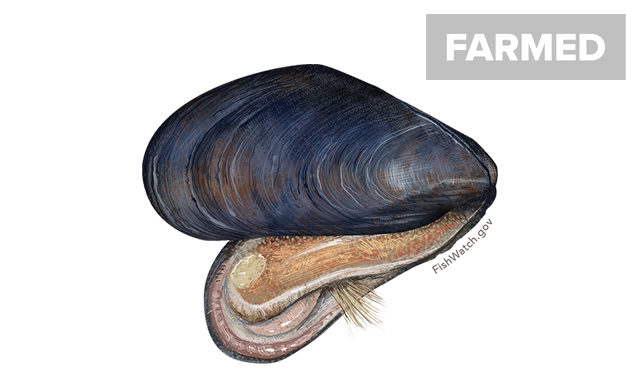 Blue Mussel
Blue Mussel
Including EFH in the FMPs
Councils are responsible for minimizing “to the extent practicable adverse effects … caused by fishing,” according to the MSA. 16 U.S.C. § 1853(a)(7). Following the 1996 Sustainable Fisheries Act amendments to the MSA, Councils amended FMPs to include four requirements related to Essential Fish Habitat:
- identifying EFH,
- identifying adverse effects in EFH,
- recommendations of how to address those threats, and
- identifying conservation, restoration, and enhancement measures to reduce threats to EFH.
Each Council approached this directive differently. Some Councils drafted individual EFH amendments for each FMP, while others issued a generic EFH amendment for all their managed fisheries. For example, the Gulf Council decided that a single, generic amendment was the only practical means of amending all seven FMPs by the required deadline. Because some species occur in two or more regions, some amendments were jointly prepared to address co-managed species.
As a result, Councils have the detailed data to identify EFH for any regulated species in a certain geographic area, in a particular level of the water column, and during a certain time of year or season.
To the Extent Practicable vs. Optimum Yield
While closing EFH to fishing is a way to conserve that habitat, it is not necessarily consistent with the MSA. One court described that practice as ignoring the MSA’s “overriding principle” in National Standard 1 that they that they achieve optimum yield on a continuing basis. Oceana, Inc. v. Evans, 2005 WL 555416 (D.D.C. March 9, 2005). CLF v. Evans, 360 F.3d 21 (1st Cir. 2004).
Habitat Areas of Particular Concern
Additionally, Councils should identify vulnerable areas of EFH as Habitat Areas of Particular Concern (HAPC). The MSA requires identifying vulnerable EFH considering the habitat’s:
- Sensitivity to the human environmental degradation;
- Susceptibility to development; and
- Rarity and ecological significance.
According to the regulations for the MSA, the word “should” is used to indicate it is strongly recommended. 50 C.F.R. § 600.305(c)(3). Courts have considered the obligation to identify HAPCs in FMPs as “strongly recommended” but not necessary to have a legally-sufficient FMP. Oceana, Inc. v. Evans, 2005 WL 555416 (D.D.C. March 9, 2005).
| Map of HAPC | |
| To give an example of HAPC identified by a Council, the South Atlantic FMC’s designation is shown on this map: | |
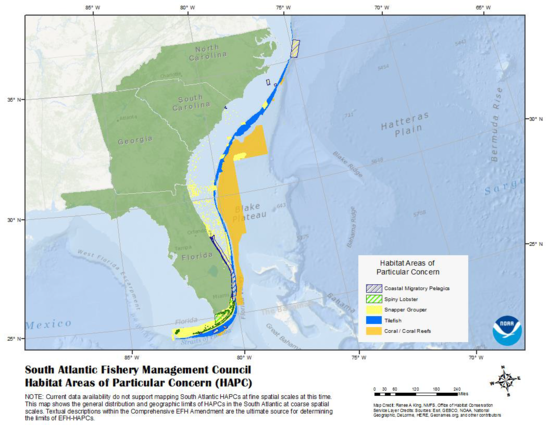 |
|
Potentially adverse effects to EFH come from both fishing activities (such as gear impacts on habitat or overfishing) and non-fishing related activities (such as dredging, fill, excavation, mining, impoundment, discharge, runoff, the introduction of exotic species, and the conversion of aquatic habitat). The Councils recommended actions to counter the identified threats and to conserve, restore, and enhance EFH. The measures may include minimizing adverse effects from fishing activities, such as fishing gear restrictions, time and area closures, and harvest limits. The measures can include environmental practices, such as restoring coastal areas, restoring habitat in upland areas, water quality efforts, watershed analysis/planning, and habitat creation.
The goal of the EFH provisions is to widen the focus of fishery management from harvest restrictions to include improving habitat. However, many identified threats to habitat fall outside of a Council’s jurisdiction. The Councils have the authority to regulate and limit fishing activities, as mentioned, but not other activities that could harm habitat such as oil and gas development or agricultural runoff. When human-made environmental changes contribute to the downward trends, such as the growing dead zone in the Gulf of Mexico, Councils have few options besides changing harvesting practices. This could result in significant restrictions on the use of some fishing gear, including trawls, as Councils try to balance their lack of authority over the environmental causes.
Consultation for Impacts to EFH
If any federal or state agency plans to take actions that might affect EFH, that so-called action agency must consult with NMFS. (18 U.S.C. § 1855(b)(4)(A).) The action agency will submit information to NMFS including a description of the action, an analysis of the potential adverse effects on EFH and managed species, and the proposed mitigation. (50 C.F.R. § 600.920(e)(3).) If, after reviewing the information, NMFS determines that the action will “adversely affect any essential fish habitat,” NMFS will recommend measures that can be taken by the agency to conserve the habitat. The next step is for the action agency to reply within 30 days describing what measures it will take to avoid, mitigate, or offset the impact of the activity.
Councils have a minor role in the consultation process compared to NMFS. Under the law, Councils may comment and make recommendations to the Secretary and any federal or state agency concerning an activity it deems may affect the habitat of a fishery resource under its authority. However, where an activity is like to substantially affect the habitat of an anadromous fishery resource under its authority, such as salmon habitat, Councils must make recommendations.
For a fishery resource disaster to be found under Section 1861a, there must be a commercial fishery failure due to:
Essential Fish Habitat Consultation
The 2020 permits for a finfish aquaculture project provide an example of EFH consultation. The U.S. Corps of Engineers and the Environmental Protection Agency prepared an EFH assessment for Velella Epsilon project to be located 45 miles off the coast of Sarasota, FL. According to the Corps, the EFH assessment determined that discharge related to the installation and removal of the operation would be minimal and short-term, and would not result in substantial adverse effects on EFH, HAPC, or managed species within the facility area. NMFS concurred with the assessment, and consultation was concluded. See, U.S. Army Corps of Engineers, Public Notice Re: Ocean Era, LLC (SAJ-2017-03488 (SP-KRD) (Oct. 5, 2020).
EFH in State Waters
The FMP amendments authorize designating and setting conservation measures for EFH in both state and federal waters. Although the Councils’ jurisdiction over fisheries is limited to federal waters, the EFH provisions of the Magnuson-Stevens Act apply throughout the range of managed species, often extending into state waters for some life stages for anadromous species (those that leave the ocean to spawn in freshwater, such as salmon) or catadromous species (those who leave freshwater to spawn in marine water, such as eels). Additionally, estuaries, which act as nurseries for many fish, are state waters for the purpose of fish management.
The consultation requirements are different when only state waters are involved. Federal agencies still must consult with NMFS on actions that may adversely affect EFH in state waters, but state agencies are not required to notify NMFS for impacts to their waters resulting from state actions. However, NMFS must still provide conservation recommendations for proposed state actions in state-water EFH. NMFS also has the authority to comment on permits issued by the Corps of Engineers under the Fish and Wildlife Coordination Act and can request decisions be made by personnel above the district level.
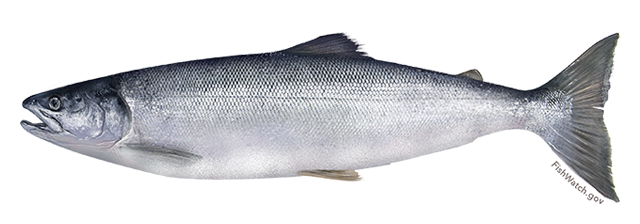 Sockeye Salmon
Sockeye Salmon
Marine Protected Areas
The term “marine protected area” means an area in the seas or oceans with special conservation or management practices. They can also include freshwater areas such as the Great Lakes. Some examples include marine sanctuaries, marine reserves, and marine national monuments.
A marine protected area is a geographically defined space where special restrictions are applied to protect some aspect of the marine ecosystem including plants, animals, and natural habitats. Some areas are closed to all fishing or to specific equipment types during certain sensitive times of the season. Fishery management depends on how fishing activities were defined when the area was established. Marine protected areas can provide a multi-species approach to management while reducing the number of regulations, and can improve stock numbers outside of the areas. However, they sometimes increase the fishing pressure outside of the reserve area and sometimes end fishing in traditional fishing grounds.
Marine protected areas can be created by different means. Marine protected areas can be established by Congress (under its constitutional authority in Art. IV, § 3, cl. 2), or by the President (under the Antiquities Act), or by the Department of Commerce (under the National Marine Sanctuaries Act). The names are slightly different based on which authority was used to create the area, which can also impact management.
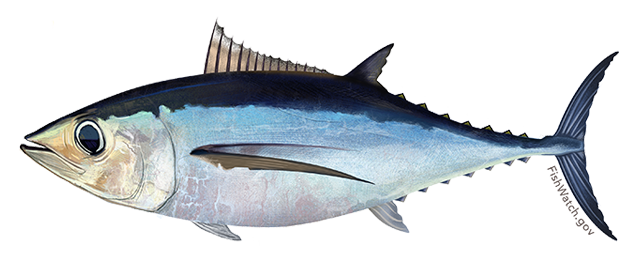 North Atlantic Albacore Tuna
North Atlantic Albacore Tuna
Marine National Monuments (MNM) are created under the Antiquities Act which authorizes the President to identify federal lands worthy of protection because of historic or scientific reasons. Several presidents have used the act to establish Marine National Monuments in the United States’ federal waters totaling millions of miles. While the undersea lands are the legal basis for the monument, the waters above the lands are also regulated. For example, the Papahanaumokuakea MNM near Hawai’i was designated by President George W. Bush as 139,793 sq. miles and expanded by President Barack Obama to 442,781 sq. miles. The Presidential Proclamations establishing the monuments prohibited commercial and recreational fishing as of a certain date. Two fishers challenged these restrictions under tort law but lost. Dettling v. United States, 983 F. Supp. 2d 1184 (D. Haw. 2013).
While closing a fishery impacts some fishers, overall, it may prove helpful by protecting spawning areas and allowing more fish to reach maturity before recruitment. According to one study, following the ban on commercial fishing in the Papahanaumokuakea MNM, U.S. fisheries suffered little if any impact, and Hawai’ian longline fisheries showed an increase in catch and revenue.
The Seamounts MNM, 130 miles off the coast of Massachusetts, is 4,913 sq. miles, and its designation also was challenged through litigation. Commercial fishers challenged the President’s authority to prohibit commercial fishing in the monument. The federal court hearing the case held that the President was authorized to designate lands in the Exclusive Economic Zone as national monuments. Massachusetts Lobstermen’s Association v. Ross, 349 F. Supp. 3d 48 (D.D.C. 2018), aff’d 945 F. 3d 535 (D.C. Cir. 2019), cert. denied 141 S. Ct. 979 (2021).The court said that fishing in the area could be restricted because the President protected the area’s ecosystem with the monument’s designation. In 2020, President Trump issued a proclamation changing the management of the Seamounts MNM to allow commercial fishing. A pending lawsuit challenged the President’s authority to change the management of the monument.
A different law, the National Marine Sanctuaries Act (NMSA), authorizes the Department of Commerce to designate areas of the marine environment and issue regulations pertaining to the management of those areas. NOAA administers the NMSA. Some examples of National Marine Sanctuaries include the Olympic Coast National Marine Sanctuary, Thunder Bay National Marine Sanctuary, and the Florida Keys National Marine Sanctuary. Sanctuaries also can be nominated by communities.
| Map of U.S. National Marine Sanctuaries | |
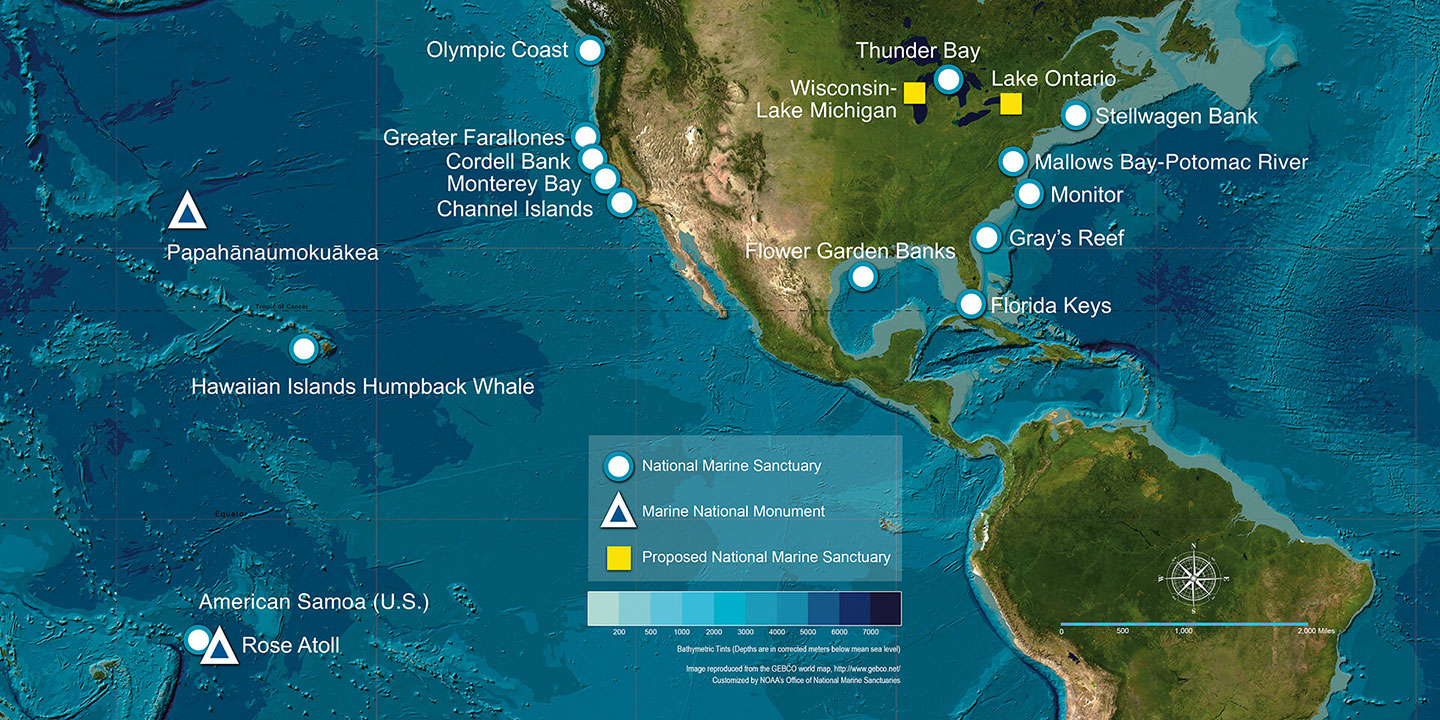 |
|
Image Source: NOAA |
A “Marine reserve” is a term describing a type of marine protected area with the highest restriction on use. A typical marine reserve does not allow hunting, fishing, or collecting. They sometimes are referred to as “no take areas.” Even anchoring a boat may be prohibited, if that activity would harm the area, such as by damaging coral. Marine reserves can be designated within a marine protected area, providing conservation purposes different from the area as a whole. According to NOAA, approximately 3 percent of area within all marine protected areas are conserved as no-take marine reserves, and the Papahanaumokuakea MNM contains most of that area (over 90 percent).
In May 2000, President Clinton signed Executive Order 13158 calling for the expansion and protection of Marine Protected Areas (MPAs). It defined an MPA broadly as "any area of the marine environment reserved by Federal, State, territorial, tribal, or local laws or regulations to provide lasting protection for part or all of the natural and cultural resources therein." Executive orders interpret, but do not expand, statutory powers. Therefore, this Executive Order is more in the nature of directing federal agencies to focus on marine areas and did not create authority that was different from the Antiquities Act or the NMSA. The Order calls for each Federal agency that establishes or manages MPAs to enhance or expand protection of existing MPAs and establish or recommend new MPAs. The Department of Commerce carries out the requirements of the Executive Order through its Marine Protected Area Center.
Information on marine reserves in each fishery is available from regional councils.
« Go to Part 12 | Part 13: Management through Habitat Protection | Go to Part 14 »
